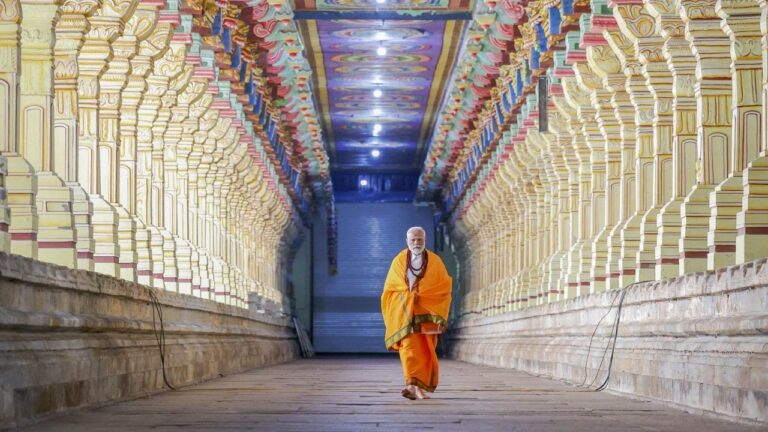News Desk, Kolkata : In a grand culmination after 550 years of anticipation, Prime Minister Narendra Modi is set to perform the ‘Pran Pratishtha’ at the Ram Temple in Ayodhya, marking the establishment of Lord Ram’s divine presence. The event is not only a significant religious ceremony but also a momentous occasion drawing distinguished individuals from around the world.
However, Modi, known for his disciplined routines, is observing a special 11-day austerity period leading up to the event, following the ‘Yam Niyam’ guidelines. During this period, the Prime Minister is living a simple life, consuming only water from the Ganges and traveling to revered Indian temples associated with Lord Ram, immersing himself in the spiritual essence.

As the day of Pran Pratishtha approaches on January 22, Modi’s schedule is meticulously planned :
– 10:25 AM : Arrival at the newly constructed Maharshi Valmiki International Airport in Ayodhya.
– 10:45 AM : Transition from the airport to the Ayodhya Heliport.
– 10:55 AM : Arrival at the birthplace of Lord Ram, commencing the day’s sacred events.
The centerpiece of the day is the main Pran Pratishtha ceremony, scheduled from 12:05 PM to 12:55 PM. This auspicious moment has been highlighted by the pundits as the most propitious time for the divine consecration. After the ceremony, Prime Minister Modi will proceed to the public rally venue.
At 12:55 PM, post the conclusion of the Pran Pratishtha ceremony, Modi will leave the premises to attend a public gathering. From 1:00 PM onwards, he will engage in a dialogue with devotees, sharing insights and participating in discussions. This interactive session is expected to last until 2:00 PM.
At 2:10 PM, the Prime Minister will perform puja at the Kuber Tila Mandir in Ayodhya, marking a gesture of gratitude and reverence.
Narendra Modi’s connection with the Ram Janmabhoomi movement dates back to the late 20th century when he actively participated as an RSS pracharak (volunteer). Over the years, his devotion deepened, and he took an oath during the Ekta Yatra in 1992, vowing to return to Ayodhya when the construction of the temple begins. Keeping that pledge, Modi was present at the Bhoomi Pujan ceremony on August 5, 2020, when the foundation stone was laid for the Ram Temple.
In the current scenario, Modi’s adherence to the Yam Niyam guidelines demonstrates his commitment to spiritual practices. He has been visiting various temples, including the Kothandarama Swamy Temple in Tamil Nadu and the Ranganatha Swamy and Ramanatha Swamy Temples in Tamil Nadu, where he conducted puja ceremonies, dived into the ‘Angi Teerth’ at Rameswaram, and recited passages from the Ramayana.
As the nation eagerly awaits this historic moment, Modi’s journey is not just a political leader’s obligation but a deeply personal and spiritual commitment. It reflects a blend of cultural and religious significance, intertwining the historical narrative of Lord Ram with contemporary leadership.
This occasion is more than a political event; it is a manifestation of faith, culture, and a promise kept. Narendra Modi’s journey from an RSS volunteer in the late 20th century to the Prime Minister leading the consecration at the Ram Temple is a narrative of devotion, determination, and the fulfillment of a pledge made decades ago.
As the world witnesses this significant moment, it symbolizes India’s rich cultural heritage, religious diversity, and the enduring spirit that transcends time. The Ram Temple stands not just as a physical structure but as a testament to the resilience of faith and the embodiment of a nation’s collective aspirations.
DISCLAIMER
Our news media denounces any form of bias and disapproves of sensationalism. The disseminated news is entirely educational and aimed at social awareness. Our media maintains absolute impartiality, adhering solely to the purpose of education and social consciousness.


